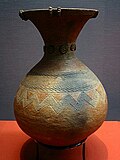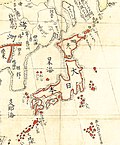The Yayoi period (弥生時代, Yayoi jidai) started in the late Neolithic period in Japan, continued through the Bronze Age, and towards its end crossed into...
28 KB (2,925 words) - 17:38, 23 October 2024
The Yayoi people (弥生人, Yayoi jin) were an ancient people that immigrated to the Japanese archipelago during the Yayoi period (300 BC–300 AD) and are characterized...
14 KB (1,592 words) - 07:25, 5 November 2024
phase of the Jōmon period to 300 BC. The Yayoi period started between 500 and 300 BC according to radio-carbon evidence, while Yayoi styled pottery was...
53 KB (5,972 words) - 13:11, 21 November 2024
History of Japan (redirect from Kamakura–Muromachi period)
around 38–39,000 years ago. The Jōmon period, named after its cord-marked pottery, was followed by the Yayoi period in the first millennium BC when new...
137 KB (16,278 words) - 12:17, 15 November 2024
period (古墳時代, Kofun jidai) is an era in the history of Japan from about 300 to 538 AD (the date of the introduction of Buddhism), following the Yayoi...
46 KB (5,478 words) - 20:21, 1 November 2024
Magatama (category Yayoi period)
shape. From the Yayoi period onwards, magatama uniformly feature a bored hole that allowed the jewels to be held on a string. The Yayoi period is marked by...
30 KB (3,376 words) - 21:29, 12 November 2024
Shinto (section Nara period)
has been traced back to Japan's Yayoi period (300 BC to 300 AD). Buddhism entered Japan at the end of the Kofun period (300 to 538 AD) and spread rapidly...
125 KB (15,864 words) - 00:29, 24 November 2024
became a key example of this. Little is known of the clothing, of the Yayoi period. In the 3rd-century Weizhi Worenchuan (魏志倭人伝 (Gishi Wajinden), a section...
67 KB (7,648 words) - 08:16, 17 November 2024
culture in northern Tōhoku and Hokkaidō that corresponds with the Yayoi period and Kofun period elsewhere. Zoku-Jōmon ("continuing cord-marking") in turn gave...
4 KB (322 words) - 15:47, 12 December 2023
The Heian period (平安時代, Heian jidai) is the last division of classical Japanese history, running from 794 to 1185. It followed the Nara period, beginning...
34 KB (4,704 words) - 10:49, 19 November 2024
Japanese people (section Jōmon and Yayoi periods)
Japanese people was not newcomers in the Yayoi period (300 BCE – 300 CE) but the people in the Jōmon period. However, Kazuro Hanihara announced a new...
47 KB (4,090 words) - 06:00, 20 November 2024
List of Japanese battles (section Yayoi Period)
The following is a list of Japanese battles, organised by date. Jimmu's Eastern Expedition (c. 7th century BCE) Takehaniyasuhiko Rebellion (c. 1st century...
25 KB (2,728 words) - 15:28, 25 October 2024
Yayoi pottery (弥生土器 Yayoi doki) is earthenware pottery produced during the Yayoi period, an Iron Age era in the history of Japan traditionally dated 300 BC...
3 KB (292 words) - 04:34, 6 February 2024
Koreans in Japan (section Yayoi period)
often limited to specific ports. In late prehistory, in the Iron Age Yayoi period (300 BCE to 300 CE), Japanese culture showed[clarify] some Korean influence...
93 KB (10,226 words) - 09:59, 11 November 2024
The Edo period (江戸時代, Edo jidai), also known as the Tokugawa period (徳川時代, Tokugawa jidai), is the period between 1603 and 1868 in the history of Japan...
89 KB (10,940 words) - 19:36, 30 October 2024
others, such as tooth ablation, persisted into the Yayoi period. As with the Jomon people, the Yayoi people left behind a distinctive material culture...
28 KB (3,365 words) - 04:39, 16 August 2024
Osaka (category Populated places with period of establishment missing)
the Yayoi period, the sediments that were deposited north of the Uemachi peninsula / plateau transformed Kawachi Bay into a lagoon. During the Yayoi period...
116 KB (10,509 words) - 23:33, 7 November 2024
Japanese pottery and porcelain (section Yayoi period)
later Jōmon period. The pottery was formed by coiling clay ropes and fired in an open fire. In about the 4th–3rd centuries BC Yayoi period, Yayoi pottery...
52 KB (5,061 words) - 16:36, 29 October 2024
Kofun (redirect from Tumulus Period)
tombs of chiefs in the Yayoi period were square-shaped mounds surrounded by ditches. The most notable example in the late Yayoi period is Tatetsuki Mound...
30 KB (2,374 words) - 17:42, 20 November 2024
Yayoi Kusama (草間 彌生, Kusama Yayoi, born 22 March 1929) is a Japanese contemporary artist who works primarily in sculpture and installation, and is also...
106 KB (10,876 words) - 16:24, 12 November 2024
The Azuchi–Momoyama period (安土桃山時代, Azuchi–Momoyama jidai) was the final phase of the Sengoku period (戦国時代, Sengoku jidai) in Japanese history from 1568...
29 KB (3,430 words) - 20:32, 4 October 2024
Inkstone artifacts at archaeological sites dating back to the earlier Yayoi period were also found to contain Chinese characters. Although some characters...
94 KB (9,725 words) - 14:09, 28 October 2024
Economic history of Japan (section Yayoi period)
period, there is evidence that these deaths were not inflicted by warfare or violence on a large enough scale to cause these deaths. The Yayoi period...
125 KB (15,501 words) - 07:08, 21 November 2024
List of time periods (redirect from Time period)
(1674–1818) Colonial period: British Raj (1858 – 1947) Independence (1947 – present) Archaic Japan Jōmon period (10,501 BC – 400 BC) Yayoi period (450 BC – 250...
29 KB (3,077 words) - 13:08, 24 November 2024
around 800 BC in the Yayoi period (1000 BC – 300 AD). A large number of bronze tsurugi made around 200 B.C. in the Yayoi period were excavated from several...
6 KB (601 words) - 12:17, 26 June 2024
The Muromachi period or Muromachi era (室町時代, Muromachi jidai), also known as the Ashikaga period or Ashikaga era (足利時代, Ashikaga jidai), is a division...
23 KB (2,921 words) - 10:49, 21 November 2024
periods in Japan, adopting rice and millet cultivation during the Middle Yayoi period. Beginning around 300 BCE, the Shellmidden population saw a steady decline...
33 KB (4,088 words) - 05:02, 24 November 2024
Naval history of Japan (section Yayoi Period)
with states on the Asian continent in the 3rd century BCE during the Yayoi period. It reached a pre-modern peak of activity during the 16th century, a...
53 KB (6,807 words) - 21:02, 23 November 2024
site in the city of Tsugaru where the Shakōkidogū was found. During the Yayoi period, the area that would become Aomori Prefecture was impacted by the migration...
97 KB (9,259 words) - 14:23, 26 September 2024
The Nara period (奈良時代, Nara jidai) of the history of Japan covers the years from 710 to 794. Empress Genmei established the capital of Heijō-kyō (present-day...
23 KB (2,415 words) - 02:02, 15 October 2024






















